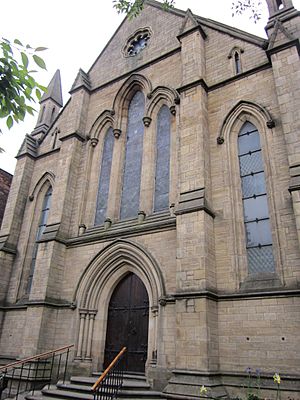Bank Street Unitarian Chapel facts for kids
Bank Street Unitarian Chapel is a special church in Bolton, England. It's a place where people who follow the Unitarian faith gather to worship. This chapel has a long and interesting history, going back hundreds of years.
Contents
A Long History
The story of Bank Street Chapel began in 1672. It started with a group of people led by Richard Goodwin. He was a Presbyterian minister who had been "ejected" from his church. This meant he was forced to leave his job because of new laws about religion.
In 1672, a special rule called the Royal Declaration of Indulgence allowed him to preach again. So, he started a new church group in Bolton. Bolton was known for being a strong Puritan town. During the English Civil War, some people even called it the Geneva of the North. This was because it reminded them of Geneva, a city known for its strict religious rules.
When Richard Goodwin passed away in 1685, John Lever took over as minister. He had also been forced out of his church before. For a while, the church group met in a building that later became a pub.
A New Home for the Chapel
After John Lever, Robert Seddon became the minister in 1692. He bought a house on Windy Bank, which later became known as Bank Street. He gave this house to the church group. It opened as a chapel in 1696. Robert Seddon was the first minister in this new building.
After Seddon, his nephew, Samuel Bourn, became the minister. By the 1720s, the church group had grown to over 1,000 people!
Changes in Beliefs
The church group started as Presbyterian. But over time, their beliefs changed. They slowly moved towards Unitarianism. This happened around the time Thomas Dixon junior was a minister. These changes caused some people to leave the church. They started a new group at Duke's Alley.
Growing and Changing
In 1789, the minister, John Holland, started a Sunday school and a library at the chapel. This helped the community learn and grow.
In 1821, the church group split because they couldn't agree on who should be the next minister. Some people stayed at Bank Street, while others went to a different church. But in 1843, the two groups came back together.
Like other Unitarian churches in places like Liverpool and Manchester, the people at Bank Street Chapel were often very involved in politics and were well-known in society. They were also a very close-knit group. Many families were connected through marriage, business, and friendships. For example, one minister, Franklin Baker, married into the Crook family, who were members of the church.
The Chapel Building
The first Bank Street building was shaped like a "T". But in 1856, a new building was constructed. It was designed by George Woodhouse. Some parts of the old building, like three special doors from the pews, were used in the new design.
Today, the building has a plaque. This plaque remembers its connection to the Eagle Street College. This was a group of local people who admired the famous American poet Walt Whitman. The chapel and its school were some of the places where they met.
Chapel Ministers
Here are some of the early ministers who served the Bank Street Chapel:
- 1672–1685: Richard Goodwin
- 1689–1692: John Lever
- 1692–1696: Robert Seddon
- 1696–1720: Samuel Bourn (Robert Seddon's nephew)
- 1720–1722: Peter Withington
- 1723–1729: Thomas Dixon senior
- 1729–1750: John Buck
- 1752–1754: Thomas Dixon junior
- 1755–1789: Philip Holland
- 1789–1820: John Holland (Philip's nephew)
- 1821–1822: Noah Jones
- 1823–1864: Franklin Baker
- 1864–1873: Jeffery Worthington
- 1874–1895: Charles Clement Coe
- 1896–: Christoper J. Street


